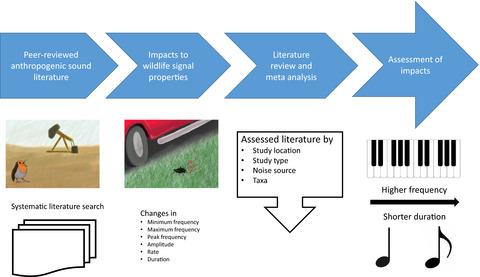当前位置:
X-MOL 学术
›
J. Appl. Ecol.
›
论文详情
Our official English website, www.x-mol.net, welcomes your
feedback! (Note: you will need to create a separate account there.)
A meta-analysis of the influence of anthropogenic noise on terrestrial wildlife communication strategies
Journal of Applied Ecology ( IF 5.0 ) Pub Date : 2021-04-01 , DOI: 10.1111/1365-2664.13880 C.A. Duquette 1 , S.R. Loss 1 , T.J. Hovick 1
中文翻译:

人为噪声对陆地野生动物传播策略影响的元分析
更新日期:2021-06-02
Journal of Applied Ecology ( IF 5.0 ) Pub Date : 2021-04-01 , DOI: 10.1111/1365-2664.13880 C.A. Duquette 1 , S.R. Loss 1 , T.J. Hovick 1
Affiliation

|
- Human-caused noise pollution dominates the soundscape of modern ecosystems, from urban centres to national parks. Although wildlife can generally alter their communication to accommodate many types of natural noise (e.g. wind, wave action, heterospecific communication), noise pollution from anthropogenic sources pushes the limits of wildlife communication flexibility by causing loud, low-pitched and near-continuous interference. Because responses to noise pollution are variable and taxa specific, multi-species risk assessments and mitigation are not currently possible.
- We conducted a meta-analysis to synthesize noise pollution effects on terrestrial wildlife communication. Specifically, we assessed: (a) the impacts of noise pollution on modulation of call rate, duration, amplitude and frequency (including peak, minimum and maximum frequency); and (b) the literature on anthropogenic noise pollution by region, taxa, study design and disturbance type.
- Terrestrial wildlife (results driven by avian studies) generally respond to noise pollution by calling with higher minimum frequencies, while they generally do not alter the amplitude, maximum frequency, peak frequency, duration and rate of calling.
- The literature on noise pollution research is biased towards birds, population-level studies, urban noise sources and study systems in North America.
- Synthesis and applications. Our study reveals the ways in which wildlife can alter their signals to contend with anthropogenic noise, and discusses the potential fitness and management consequences of these signal alterations. This information, combined with an identification of current research needs, will allow researchers and managers to better develop noise pollution risk assessment protocols and prioritize mitigation efforts to reduce anthropogenic noise.
中文翻译:

人为噪声对陆地野生动物传播策略影响的元分析
- 从城市中心到国家公园,人为噪声污染在现代生态系统的声景中占主导地位。虽然野生动物通常可以改变它们的交流以适应多种类型的自然噪声(例如风、波浪作用、异种交流),但人为来源的噪声污染会造成响亮、低音和近乎连续的干扰,从而限制了野生动物交流的灵活性。由于对噪声污染的反应是可变的,而且是针对特定类群的,因此目前无法进行多物种风险评估和缓解。
- 我们进行了一项荟萃分析来综合噪声污染对陆地野生动物交流的影响。具体而言,我们评估了: (a) 噪声污染对呼叫速率、持续时间、幅度和频率(包括峰值、最小和最大频率)调制的影响;(b) 按地区、分类群、研究设计和干扰类型划分的关于人为噪声污染的文献。
- 陆地野生动物(由鸟类研究驱动的结果)通常通过以更高的最低频率呼叫来应对噪音污染,而它们通常不会改变呼叫的幅度、最大频率、峰值频率、持续时间和呼叫率。
- 有关噪声污染研究的文献偏向于北美的鸟类、人口水平研究、城市噪声源和研究系统。
- 合成与应用。我们的研究揭示了野生动物改变信号以应对人为噪声的方式,并讨论了这些信号改变的潜在适应性和管理后果。这些信息与当前研究需求的确定相结合,将使研究人员和管理人员能够更好地制定噪声污染风险评估协议,并优先考虑减少人为噪声的缓解措施。











































 京公网安备 11010802027423号
京公网安备 11010802027423号